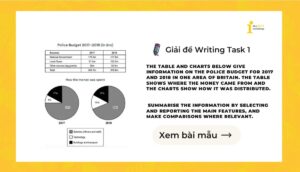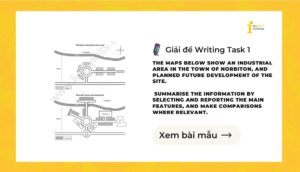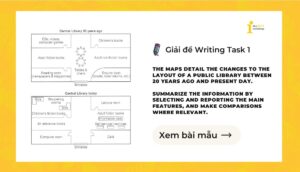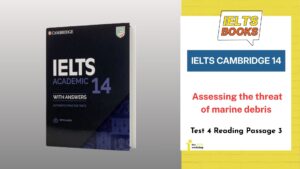Ở bài viết này The IELTS Workshop sẽ mang đến cho bạn đáp án, bản dịch và phân tích chi tiết IELTS Cambridge 20 Test 3 Reading Passage 1: Frozen Food. Hy vọng rằng qua bài viết bạn có thể tìm ra lỗi sai của bản thân từ đó nâng cao kĩ năng và kiến thức của mình khi làm dạng bài reading.
Đáp án IELTS Cambridge 20 Test 3 Reading Passage 1
| Câu hỏi | Đáp án |
|---|---|
| 1. | Potatoes |
| 2. | Butter |
| 3. | Meat |
| 4. | Crystals |
| 5. | Cellophane |
| 6. | Tin |
| 7. | Refrigerator |
| 8. | NOT GIVEN |
| 9. | TRUE |
| 10. | FALSE |
| 11. | TRUE |
| 12. | FALSE |
| 13. | NOT GIVEN |
Phân tích chi tiết IELTS Cambridge 20 Test 3 Reading Passage 1
Question 1. potatoes
Câu hỏi: People conserved the nutritional value of …, using a method of freezing then drying. (Người ta đã giữ lại giá trị dinh dưỡng của … bằng cách đông lạnh rồi làm khô.)
Vị trí: Đoạn 1.
Transcript: “… had a unique means of conserving potatoes for later consumption. They froze them overnight, then trampled them to squeeze out the moisture, then dried them in the sun. This preserved their nutritional value – if not their aesthetic appeal.”
Phân tích: Câu hỏi sử dụng cụm “conserved the nutritional value”, tương đương với trong đoạn văn là “preserved their nutritional value”. Hành động “freezing then drying” được mô tả đầy đủ trong đoạn: “froze them overnight… then dried them in the sun”. Từ cần điền là danh từ “potatoes”.
Question 2. butter
Câu hỏi: … was kept cool by ice during transportation in specially adapted trains. (… được giữ lạnh bằng đá trong quá trình vận chuyển bằng các toa tàu được thiết kế riêng.)
Vị trí: Đoạn 2.
Transcript: “In 1851, railroads … began putting blocks of ice in insulated rail cars to send butter …”
Phân tích: “Specially adapted trains” tương đương “insulated rail cars”, còn “kept cool by ice” tương đương “putting blocks of ice”. Từ cần điền “butter” là danh từ chỉ thực phẩm.
Question 3. meat
Câu hỏi: Two kinds of … were the first frozen food shipped to England. (Hai loại … là những thực phẩm đông lạnh đầu tiên được chuyển đến Anh.)
Vị trí: Đoạn 4.
Transcript: “In 1880, a shipment of Australian beef and mutton was sent, frozen, to England.”
Phân tích: Cụm “two kinds of” tương ứng với “beef and mutton”. “Frozen food shipped to England” xuất hiện nguyên văn. Danh từ chung cho “beef and mutton” là “meat”.
Question 4. crystals
Câu hỏi: Quick-freezing methods ensured that … did not spoil the food. (Phương pháp cấp đông nhanh giúp… không làm hỏng thực phẩm.)
Vị trí: Đoạn 7.
Transcript: “He developed quick-freezing techniques that reduced the damage that crystals caused.”
Phân tích: “Did not spoil” = “reduced the damage”. “Crystals” là nguyên nhân làm hỏng thực phẩm – do đó từ cần điền chính là “crystals”.
Question 5. cellophane
Câu hỏi: Packaging products with …, so the product was visible. (Sử dụng … để đóng gói thực phẩm, giúp nhìn thấy sản phẩm bên trong.)
Vị trí: Đoạn 7.
Transcript: “He also introduced the use of cellophane, the first transparent material for food packaging…”
Phân tích: “Product was visible” = “transparent material”. Cellophane là vật liệu được nhắc đến – phù hợp với yêu cầu “danh từ chỉ vật liệu”.
Question 6. tin
Câu hỏi: Frozen food became popular because of a shortage of …. (Thực phẩm đông lạnh trở nên phổ biến do thiếu hụt ….)
Vị trí: Đoạn 9.
Transcript: “World War II gave a boost to the frozen food industry because tin was being used for munitions. Canned foods were rationed to save tin…”
Phân tích: “Shortage of” = “tin was being used for munitions”, “canned foods were rationed”. Sự thiếu hụt “tin” đã khiến thực phẩm đông lạnh phổ biến hơn.
Question 7. refrigerator
Câu hỏi: A large number of homes now had a … (Một lượng lớn hộ gia đình đã sở hữu ….)
Vị trí: Đoạn 9.
Transcript: “By 1953, 33 million US families owned a refrigerator…”
Phân tích: “A large number of homes” = “33 million US families”, “had” = “owned”. Thiết bị được đề cập là “refrigerator”.
Question 8. NOT GIVEN
Câu hỏi: The ice transportation business made some Boston ship owners very wealthy in the early 1800s. (Ngành vận chuyển bằng đá đã giúp một số chủ tàu Boston trở nên giàu có đầu thế kỷ 19.)
Vị trí: Đoạn 2.
Transcript: “… ship owners from Boston, USA, had enormous blocks of Arctic ice towed all over the Atlantic…”
Phân tích: Thông tin mô tả hành động vận chuyển nhưng không nói đến việc họ giàu hay không → thông tin không có.
Question 9. TRUE
Câu hỏi: A disadvantage of the freezing process invented in Australia was that it affected the taste of food. (Một nhược điểm của phương pháp đông lạnh tại Úc là nó ảnh hưởng đến hương vị thực phẩm.)
Vị trí: Đoạn 4.
Transcript: “… crystals formed … this spoilt the flavor and texture of the food.”
Phân tích: “Affected the taste” = “spoilt the flavor”. Đây là nhược điểm rõ ràng, khớp hoàn toàn với nội dung.
Question 10. FALSE
Câu hỏi: Clarence Birdseye travelled to Labrador in order to learn how the Inuit people froze fish. (Clarence Birdseye đến Labrador để học cách người Inuit đông lạnh cá.)
Vị trí: Đoạn 5.
Transcript: “… went to Labrador in Canada to trap and trade furs. While he was there, he became fascinated with how the Inuit would quickly freeze fish…”
Phân tích: Mục đích là để buôn bán lông thú, việc học cách đông cá là tình cờ sau đó → thông tin sai.
Question 11. TRUE
Câu hỏi: Swanson Foods invested a great deal of money in the promotion of the TV Dinner. (Swanson Foods đầu tư rất nhiều tiền vào việc quảng bá sản phẩm TV Dinner.)
Vị trí: Đoạn 10.
Transcript: “… with the help of a clever name and a huge advertising budget…”
Phân tích: “Invested money in promotion” = “huge advertising budget” → đúng.
Question 12. FALSE
Câu hỏi: Swanson Foods developed a new style of container for the launch of the TV Dinner. (Swanson Foods đã tạo ra kiểu hộp mới cho TV Dinner.)
Vị trí: Đoạn 10, dòng 6–7
Transcript: “… served in the same segmented aluminum tray that was used by airlines.”
Phân tích: Không phải khay mới, mà dùng lại khay của hãng hàng không → thông tin sai.
Question 13. NOT GIVEN
Câu hỏi: The US frozen food industry is currently the largest in the world. (Ngành thực phẩm đông lạnh Mỹ hiện là lớn nhất thế giới.)
Vị trí: Đoạn 11.
Transcript: “Today, the US frozen food industry has a turnover of over $67 billion annually…”
Phân tích: Chỉ nhắc đến doanh thu, không so sánh với quốc gia nào khác → không có thông tin.
Bản dịch chi tiết IELTS Cambridge 20 Test 3 Reading Passage 1
A US perspective on the development of the frozen food industry
(Quan điểm của Hoa Kỳ về sự phát triển của ngành thực phẩm đông lạnh)
1.
At some point in history, humans discovered that ice preserved food. There is evidence that winter ice was stored to preserve food in the summer as far back as 10,000 years ago. Two thousand years ago, the inhabitants of South America’s Andean mountains had a unique means of conserving potatoes for later consumption. They froze them overnight, then trampled them to squeeze out the moisture, then dried them in the sun. This preserved their nutritional value—if not their aesthetic appeal.
(Vào một thời điểm nào đó trong lịch sử, con người đã phát hiện ra rằng băng có thể bảo quản thực phẩm. Có bằng chứng cho thấy băng vào mùa đông đã được lưu trữ để dùng trong việc bảo quản thực phẩm vào mùa hè cách đây khoảng 10.000 năm. Cách đây 2.000 năm, cư dân vùng núi Andes ở Nam Mỹ có một phương pháp độc đáo để giữ khoai tây dùng dần. Họ để khoai tây đông qua đêm, sau đó giẫm lên để ép hết nước ra, rồi đem phơi nắng. Cách này giúp giữ lại giá trị dinh dưỡng—dù không mấy hấp dẫn về mặt hình thức.)
Từ vựng cần nhớ:
- inhabitants: cư dân, người sinh sống ở một khu vực cụ thể
- conserving: bảo quản, giữ gìn để sử dụng về sau
- aesthetic appeal: sức hấp dẫn về mặt thẩm mỹ, vẻ đẹp hình thức
2.
Natural ice remained the main form of refrigeration until late in the 19th century. In the early 1800s, ship owners from Boston, USA, had enormous blocks of Arctic ice towed all over the Atlantic for the purpose of food preservation. In 1851, railroads first began putting blocks of ice in insulated rail cars to send butter from Ogdensburg, New York, to Boston.
(Băng tự nhiên vẫn là hình thức làm lạnh chủ yếu cho đến cuối thế kỷ 19. Vào đầu những năm 1800, các chủ tàu ở Boston, Mỹ đã cho kéo những khối băng khổng lồ từ Bắc Cực đi khắp Đại Tây Dương để bảo quản thực phẩm. Năm 1851, đường sắt bắt đầu sử dụng các khối băng đặt trong toa xe cách nhiệt để vận chuyển bơ từ Ogdensburg, New York đến Boston.)
Từ vựng cần nhớ
- insulated: được cách nhiệt, dùng để ngăn nhiệt truyền qua
3.
Finally, in 1870, Australian inventors found a way to make ‘mechanical ice’. They used a compressor to force a gas—ammonia at first and later Freon—through a condenser. The compressed gas gave up some of its heat as it moved through the condenser. Then the gas was released quickly into a low-pressure evaporator coil where it became liquid and cold. Air was blown over the evaporator coil and then this cooled air passed into an insulated compartment, lowering its temperature to freezing point.
(Cuối cùng, vào năm 1870, các nhà phát minh người Úc đã tìm ra cách tạo ra “đá cơ học”. Họ sử dụng một máy nén để ép một loại khí—ban đầu là amoniac và sau đó là Freon—qua một bộ ngưng tụ. Khí bị nén sẽ tỏa ra một phần nhiệt khi đi qua bộ ngưng tụ. Sau đó, khí được giải phóng nhanh chóng vào một cuộn dây bay hơi có áp suất thấp, nơi nó trở thành chất lỏng và lạnh. Không khí được thổi qua cuộn dây bay hơi, rồi luồng không khí lạnh này đi vào một khoang cách nhiệt, làm giảm nhiệt độ xuống đến điểm đóng băng.)
Từ vựng cần nhớ:
- compressor: máy nén (thiết bị dùng để nén khí)
- evaporator coil: cuộn ống bay hơi (bộ phận làm lạnh trong hệ thống lạnh)
4.
Initially, this process was invented to keep Australian beer cool even in hot weather. But Australian cattlemen were quick to realize that, if they could put this new invention on a ship, they could export meat across the oceans. In 1880, a shipment of Australian beef and mutton was sent, frozen, to England. While the food frozen this way was still palatable, there was some deterioration. During the freezing process, crystals formed within the cells of the food, and when the ice expanded and the cells burst, this spoilt the flavor and texture of the food.
(Ban đầu, quy trình này được phát minh để giữ bia Úc luôn mát ngay cả trong thời tiết nóng. Tuy nhiên, những người chăn nuôi gia súc ở Úc nhanh chóng nhận ra rằng nếu có thể đặt phát minh mới này lên tàu, họ sẽ có thể xuất khẩu thịt đi khắp đại dương. Năm 1880, một lô hàng gồm thịt bò và cừu đông lạnh từ Úc đã được gửi đến Anh. Mặc dù thực phẩm được đông lạnh theo cách này vẫn có thể ăn được, nhưng có một số sự suy giảm chất lượng. Trong quá trình đông lạnh, các tinh thể băng hình thành bên trong tế bào của thực phẩm, và khi băng giãn nở làm vỡ các tế bào, điều này làm giảm hương vị và kết cấu của thực phẩm.)
Từ vựng cần nhớ:
- palatable: dễ ăn, chấp nhận được về hương vị
- deterioration: sự suy giảm, xuống cấp (về chất lượng hoặc tình trạng)
- texture: kết cấu, độ mềm/mịn/cứng của thực phẩm khi ăn
5.
The modern frozen food industry began with the indigenous Inuit people of Canada. In 1912, a biology student in Massachusetts, USA, named Clarence Birdseye, ran out of money and went to Labrador in Canada to trap and trade furs. While he was there, he became fascinated with how the Inuit would quickly freeze fish in the Arctic air. The fish looked and tasted fresh even months later.
(Ngành công nghiệp thực phẩm đông lạnh hiện đại bắt đầu từ người Inuit bản địa ở Canada. Năm 1912, một sinh viên sinh học ở Massachusetts, Hoa Kỳ, tên là Clarence Birdseye, hết tiền và đã đến Labrador, Canada để săn bắt và buôn bán lông thú. Trong thời gian ở đó, ông bị cuốn hút bởi cách người Inuit nhanh chóng đông lạnh cá trong không khí Bắc Cực. Những con cá ấy trông vẫn tươi ngon và có hương vị như mới, dù đã để hàng tháng trời.)
Từ vựng cần nhớ:
- indigenous: bản địa, thuộc về người dân gốc của một khu vực
- fascinated: bị cuốn hút, say mê
- Arctic: thuộc vùng Bắc Cực (khu vực cực Bắc lạnh giá của Trái Đất)
6.
Birdseye returned to the USA in 1917 and began developing mechanical freezers capable of quick-freezing food. Birdseye methodically kept inventing better freezers and gradually built a business selling frozen fish from Gloucester, Massachusetts. In 1929, his business was sold and became General Foods, but he stayed with the company as director of research, and his division continued to innovate.
(Birdseye quay trở lại Hoa Kỳ vào năm 1917 và bắt đầu phát triển các tủ đông cơ học có khả năng làm đông thực phẩm nhanh chóng. Birdseye đã kiên trì phát minh ra những loại tủ đông tốt hơn một cách có hệ thống và dần dần xây dựng một doanh nghiệp bán cá đông lạnh từ Gloucester, bang Massachusetts. Năm 1929, doanh nghiệp của ông được bán lại và trở thành một phần của General Foods, nhưng ông vẫn làm việc tại công ty với vai trò giám đốc nghiên cứu và bộ phận của ông tiếp tục đổi mới.)
Từ vựng cần nhớ:
- mechanical freezer: tủ đông cơ học, thiết bị làm lạnh bằng cơ chế nén khí
- methodically: một cách có hệ thống, tuần tự và cẩn thận
- innovate: đổi mới, tạo ra những ý tưởng hoặc sản phẩm mới
7.
Birdseye was responsible for several key innovations that made the frozen food industry possible. He developed quick-freezing techniques that reduced the damage that crystals caused, as well as the technique of freezing the product in the package it was to be sold in. He also introduced the use of cellophane, the first transparent material for food packaging, which allowed consumers to see the quality of the product. Birdseye products also came in convenient size packages that could be prepared with a minimum of effort.
(Birdseye chịu trách nhiệm cho một số cải tiến quan trọng giúp ngành công nghiệp thực phẩm đông lạnh trở nên khả thi. Ông đã phát triển các kỹ thuật đông lạnh nhanh giúp giảm thiểu tổn hại do các tinh thể băng gây ra, đồng thời tạo ra phương pháp đông lạnh sản phẩm ngay trong bao bì sẽ dùng để bán. Ông cũng giới thiệu việc sử dụng cellophane – loại vật liệu trong suốt đầu tiên dùng để đóng gói thực phẩm – cho phép người tiêu dùng nhìn thấy chất lượng của sản phẩm. Các sản phẩm của Birdseye còn được đóng gói với kích thước tiện lợi, dễ chuẩn bị chỉ với rất ít công sức.)
Từ vựng cần nhớ:
- crystals: các tinh thể (ở đây là tinh thể băng hình thành trong thực phẩm khi đông lạnh)
- cellophane: chất liệu nhựa trong suốt dùng để bọc thực phẩm
- convenient: tiện lợi, dễ sử dụng
8.
But there were still obstacles. In the 1930s, few grocery stores could afford to buy freezers for a market that wasn’t established yet. So, Birdseye leased inexpensive freezer cases to them. He also leased insulated railroad cars so that he could ship his products nationwide. However, few consumers had freezers large enough or efficient enough to take advantage of the products.
(Tuy nhiên, vẫn còn nhiều trở ngại. Vào những năm 1930, rất ít cửa hàng tạp hóa có đủ khả năng mua tủ đông vì thị trường thực phẩm đông lạnh vẫn chưa được thiết lập. Do đó, Birdseye đã cho họ thuê các tủ đông giá rẻ. Ông cũng thuê các toa tàu có cách nhiệt để vận chuyển sản phẩm đi khắp đất nước. Tuy nhiên, lúc đó không có nhiều người tiêu dùng sở hữu tủ đông đủ lớn hoặc đủ hiệu quả để tận dụng các sản phẩm này.)
Từ vựng cần nhớ:
- obstacles: trở ngại, khó khăn
- insulated: có cách nhiệt, được giữ nhiệt
- take advantage of: tận dụng
9.
Sales increased in the early 1940s, when World War II gave a boost to the frozen food industry because tin was being used for munitions. Canned foods were rationed to save tin for the war effort, while frozen foods were abundant and cheap. Finally, by the 1950s, refrigerator technology had developed far enough to make these appliances affordable for the average family. By 1953, 33 million US families owned a refrigerator, and manufacturers were gradually increasing the size of the freezer compartments in them.
(Doanh số tăng vào đầu những năm 1940, khi Chiến tranh Thế giới thứ hai thúc đẩy ngành công nghiệp thực phẩm đông lạnh vì thiếc được sử dụng làm đạn dược. Thực phẩm đóng hộp được phân phối theo khẩu phần để dành thiếc cho nỗ lực chiến tranh, trong khi thực phẩm đông lạnh lại dồi dào và rẻ. Cuối cùng, đến những năm 1950, công nghệ tủ lạnh đã phát triển đủ để làm cho những thiết bị này trở nên phù hợp với túi tiền của một gia đình trung bình. Đến năm 1953, 33 triệu gia đình Mỹ đã sở hữu tủ lạnh, và các nhà sản xuất dần dần tăng kích thước ngăn đá của tủ lạnh.)
Từ vựng cần nhớ:
- rationed: bị phân phối theo định mức, bị hạn chế
- munitions: đạn dược
- affordable: có thể chi trả được, vừa túi tiền
- compartments: ngăn, khoang (trong thiết bị hoặc phương tiện)
10.
1950s families were also looking for convenience at mealtimes, so the moment was right for the arrival of the ‘TV Dinner’. Swanson Foods was a large, nationally recognized producer of canned and frozen poultry. In 1954, the company adapted some of Birdseye’s freezing techniques, and with the help of a clever name and a huge advertising budget, it launched the first ‘TV Dinner’. This consisted of frozen turkey, potatoes and vegetables served in the same segmented aluminum tray that was used by airlines. The product was an instant success. Within a year, Swanson had sold 13 million TV dinners. American consumers couldn’t resist the combination of a trusted brand name, a single-serving package and the convenience of a meal that could be ready after only 25 minutes in a hot oven. By 1959, Americans were spending $2.7 billion annually on frozen foods, and half a billion of that was spent on ready-prepared meals such as the TV Dinner.
(Các gia đình những năm 1950 cũng tìm kiếm sự tiện lợi trong bữa ăn, vì vậy thời điểm đó đã chín muồi cho sự ra đời của ‘Bữa tối xem TV’. Swanson Foods là một nhà sản xuất gia cầm đóng hộp và đông lạnh lớn, được công nhận trên toàn quốc. Năm 1954, công ty đã điều chỉnh một số kỹ thuật đông lạnh của Birdseye và với sự trợ giúp của một cái tên thông minh và ngân sách quảng cáo khổng lồ, công ty đã tung ra ‘Bữa tối xem TV’ đầu tiên. Sản phẩm này bao gồm gà tây đông lạnh, khoai tây và rau củ được phục vụ trong cùng một khay nhôm phân đoạn được các hãng hàng không sử dụng. Sản phẩm đã thành công ngay lập tức. Trong vòng một năm, Swanson đã bán được 13 triệu bữa tối xem TV. Người tiêu dùng Mỹ không thể cưỡng lại sự kết hợp giữa một thương hiệu đáng tin cậy, một gói phục vụ một lần và sự tiện lợi của một bữa ăn có thể sẵn sàng chỉ sau 25 phút trong lò nướng nóng. Đến năm 1959, người Mỹ chi 2,7 tỷ đô la mỗi năm cho thực phẩm đông lạnh và nửa tỷ đô la trong số đó được chi cho các bữa ăn được chế biến sẵn như Bữa tối xem TV.)
Từ vựng cần nhớ:
- advertising budget: ngân sách quảng cáo
- segmented: được chia ngăn
- instant success: thành công tức thì
- single-serving package: khẩu phần ăn dành cho một người
11.
Today, the US frozen food industry has a turnover of over $67 billion annually, with $26.6 billion of that sold to consumers for home consumption. The remaining $40 billion in frozen food sales come through restaurants, cafeterias, hospitals and schools, and that represents a third of the total food service sales.
(Ngày nay, ngành công nghiệp thực phẩm đông lạnh của Hoa Kỳ có doanh thu hơn 67 tỷ đô la mỗi năm, trong đó 26,6 tỷ đô la là doanh thu từ người tiêu dùng mua về sử dụng tại nhà. Phần còn lại, 40 tỷ đô la, đến từ doanh số bán hàng cho các nhà hàng, căng tin, bệnh viện và trường học – chiếm khoảng một phần ba tổng doanh thu của ngành dịch vụ thực phẩm.)
Từ vựng cần nhớ:
- consumption: sự tiêu dùng
- turnover: doanh thu
Series giải đề IELTS Cambridge 20:
- [PDF + Audio] Cambridge IELTS 20: Cập nhật mới nhất (Bản đẹp)
- Đáp án & Lời giải chi tiết Cambridge 20: Test 1 – Test 4
- Giải chi tiết Cambridge 20 Test 3 Listening Part 1:
- Giải chi tiết Cambridge 20 Test 3 Listening Part 2:
- Giải chi tiết Cambridge 20 Test 3 Listening Part 3:
- Giải chi tiết Cambridge 20 Test 3 Listening Part 4:
- Giải chi tiết IELTS Cambridge 20 Test 3 Reading Passage 1: Frozen Food
- Giải chi tiết IELTS Cambridge 20 Test 3 Reading Passage 2: Can the planet’s coral reefs be saved?
- Giải chi tiết IELTS Cambridge 20 Test 3 Reading Passage 3: Robots and us
- [PDF + Audio] Trọn bộ Cambridge Practice Tests For IELTS 1 – 20 mới nhất
Nếu bạn đang tìm kiếm một lộ trình học bài bản, phương pháp rõ ràng và sự đồng hành từ những giảng viên giàu kinh nghiệm, The IELTS Workshop chính là nơi bạn có thể tin tưởng.
Khám phá khóa học IELTS miễn phí tại Website The IELTS Workshop để được trải nghiệm phương pháp học hiện đại, lộ trình cá nhân hóa cùng đội ngũ giảng viên chuyên môn cao ngay nhé!

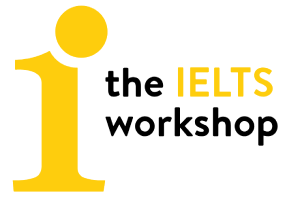
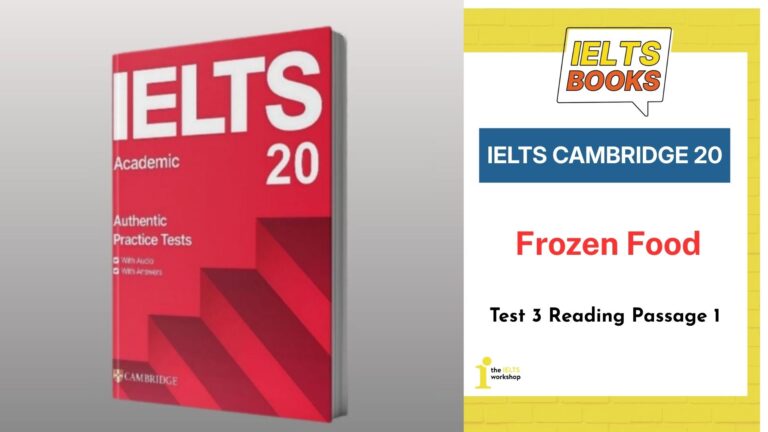
![[PDF + Audio] Trọn bộ Cambridge Practice Tests For IELTS 1 – 20 mới nhất](https://onthiielts.com.vn/wp-content/uploads/2020/04/cam-1-14-764x400.jpg)
![[PDF + Audio] Cambridge IELTS 20: Cập nhật mới nhất (Bản đẹp)](https://onthiielts.com.vn/wp-content/uploads/2025/07/Cambridge-IELTS-20-300x169.jpg)
